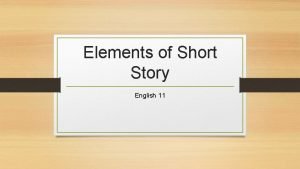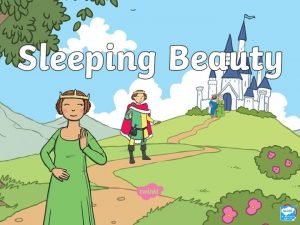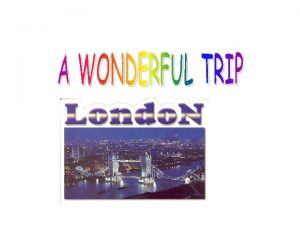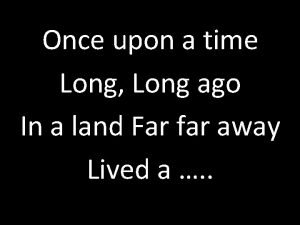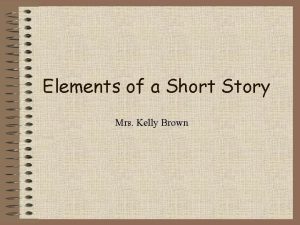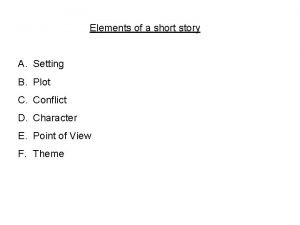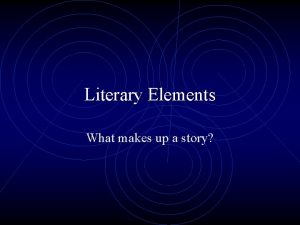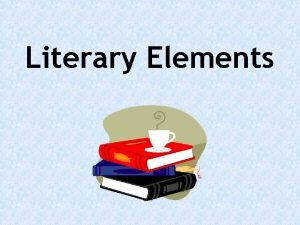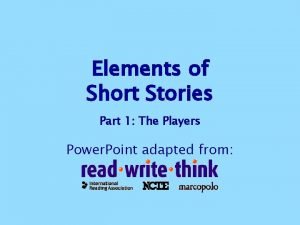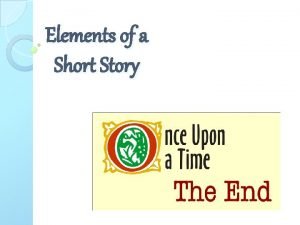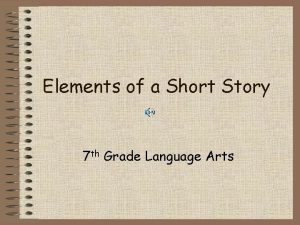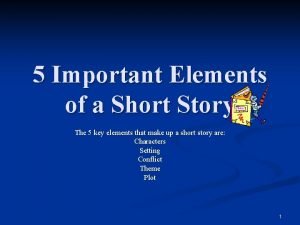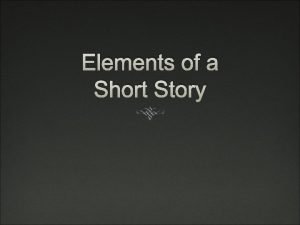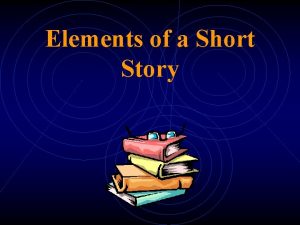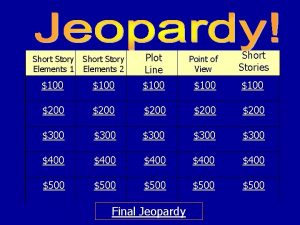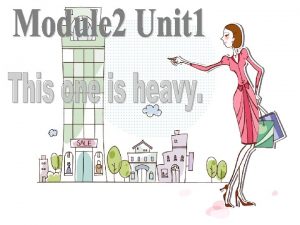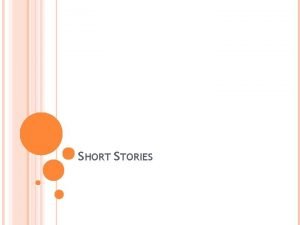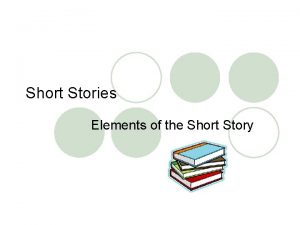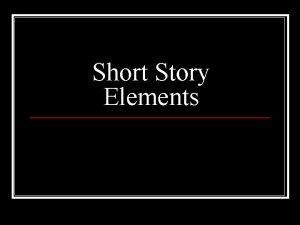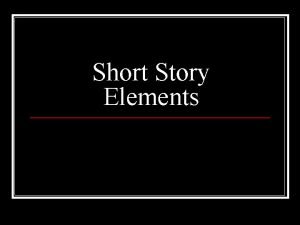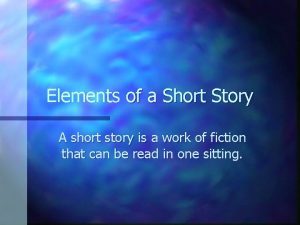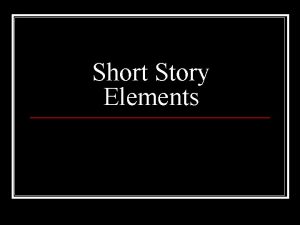Short Story Elements The Five Components The Long

















- Slides: 17

Short Story Elements The Five Components

The Long and Short of the Short Story 1 st definition: p A short story is a “short piece of fiction aiming at unity of characterization, theme and effect. ” 2 nd definition: p A short story is a piece of prose fiction, which can be read at a single sitting. n Prose- the ordinary language people use in speaking or writing.

Character p The most important element of a short story p The people the story is about p The main character is called the Protagonist —may be good or bad, or a combination of the two, but the action revolves around her/him. n protagonist - the main character in a literary work p An antagonist is any character, feeling, or situation, which acts against the protagonist in any way. n antagonist - one that contends with or opposes another: adversary, opponent

Character p Often populated with characters other than the protagonist or antagonist. n n n Minor character--often provides support and illuminates the protagonist, sometimes called the foil Static character--A character who remains fundamentally the same. Dynamic character--A character who changes in some important way. Characters who are not developed in the story are called flat characters. Characters who are shown in many lights are called round characters.

Characterization p Direct—the writer tells you directly about the character. n n p “She had skin as white as snow. ” “She was an evil stepmother. ” Indirect—the writer reveals the personality through his/her physical description, thoughts, feelings and words, the comments and reactions of others, and the actions of the character n n “He walked right past the crying child. ” “The homeless person begged for charity; he gave him his last dollar. ”

Discussion— “All the Years…” What kind of a boy is Alfred? What are some of the things Alfred did in the story to show this? p Had Alfred ever been in trouble before? What are some of the things Mrs. Higgins did and said in the story that show this? p Does Alfred love his mother? Give reasons why you think as you do. p Why do you think Alfred decided to go to the kitchen to see his mother? p What did the author mean in the last paragraph when he said, “this was the first time he had ever really seen his mother”? p

Setting p The time and location in which the story takes place. p Helps you understand the characters. p Location, location! n Whether it’s a physical locale that is exotic, or a turbulent historical period, making unique and intriguing choices automatically transforms any story.

Plot/Conflict The arrangement of ideas and or incidents which lead from the opening of the story to the climax p About a conflict or struggle that the main character goes through. p n May be with another character, or with the way things are, or with something inside the character, like needs or feelings. Exposition (Initial Incident) is the information needed to understand a story. p Complication (Rising Action) is the catalyst that begins the major conflict. p

Plot/Conflict p Climax is the turning point in the story that occurs when characters try to resolve the complication. p Falling Action - Events leading to the resolution. p Resolution is the set of events that bring the story to a close.

Examples of Conflict p Man vs. Man - Two or more characters are at odds. Ex: detective vs. serial killer. p Man vs. Society - The character is frowned upon by society or those in power – ex: The poor boy who falls in love with a girl from a wealty family. p Man vs. Nature - The character must fight against natural forces to survive. Ex: Plane crashes in the wilderness. p Man vs. Self - Takes place within the character as she/he tries to decide what to do about a situation. – Ex: Rocky

Point of View p Pertains to who tells the story and the relationship of the narrator to the characters in the story. p The action in a short story can be seen through… Omniscient third person point of view: the narrator knows all the thoughts, motives and feelings of each character n Limited third person: the narrator can describe the characters and what they do and say but not their thoughts and feelings. n First person: the main character tells his own story n

Theme Might not be obvious at first p Are not the subject of the story (the people it’s about) p Holds the story together p Often a lesson or message the author wants to convey p Reflects the values of the entire work, not just one or two episodes. p Describes the general meaning of the work, not the specific events, actions, or plot. Example: p n Theme: A good man will help anyone who needs help, regardless of whether that person is an enemy. Plot: A certain man was traveling from Jerusalem to Jericho

Theme p The meaning released by the work when we take all aspects of the work in its entirety into account. p In North American literature, several themes are evident which reflect and define our society. The dominant ones might be: Innocence/experience, life/death, n Madness/sanity, love/hate, n Society/individual, known/unknown. n

How to Identify Theme Identify the central topics or "big ideas. " Identify how the characters relate to the central topic. Organize your thoughts

Identify the central topics or "big ideas. " Before you read a work, look at the title. Does it give any clues as to what the book will be about? And Then There Were None is a great mystery book by Agatha Christie. The title alone hints that there are going to be many disappearances or murders. In the aforementioned Little Women, the reader knows that she is going to be reading a book about young girls and that theme might possibly have something to do with them. As you read the book, look for the central topic of the book. When you identify the central topics of the book, write them down. Getting a feel for the central topics of the book will help you begin to

Identify how the characters relate to the central topic. p Identify how the characters relate to the central topic. As you read the story, try to see how the characters relate to the central topic. Pay attention to key events, dialogue, ideas, metaphors, and changes in a character's actions or beliefs. In Little Women, Meg is faced with her poverty when she attends a party. The other girls dress her up like a doll and she begins to act like someone that she is not. When she is confronted about this by another character, she becomes ashamed and alarmed at her behavior. Seeing how Meg deals with this event and knowing that one of the central topics of the book is growing up, one can conclude that a

Organize your thoughts p Organize your thoughts. If you are still struggling with finding theme of a story, try to organize your thoughts by writing them down. Write down the central topic and then include examples from the story that support that topic. What did the characters do? What did they say? How did they react? Sit back and look at what you wrote and try to see the "big picture" of the story. What was that story all about? What was the author trying to tell me? With a little bit of time and thought, theme will come to you.
 Short short short long long long short short short
Short short short long long long short short short Five elements of short story
Five elements of short story Story
Story Five elements and five senses
Five elements and five senses Once upon a time there lived a little girl
Once upon a time there lived a little girl Once there lived a king story
Once there lived a king story Once upon a long time ago
Once upon a long time ago Once upon a time long ago
Once upon a time long ago Kelly short story setting
Kelly short story setting Short story with elements
Short story with elements Từ ngữ thể hiện lòng nhân hậu
Từ ngữ thể hiện lòng nhân hậu Elements of a short story video
Elements of a short story video Cinderella internal conflict
Cinderella internal conflict Elements of a short story powerpoint
Elements of a short story powerpoint Elements of short stories
Elements of short stories 7 elements of a short story with meaning
7 elements of a short story with meaning 5 important elements of a short story
5 important elements of a short story Identify the elements of short story. *
Identify the elements of short story. *

